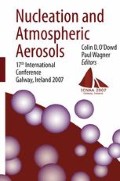The hygroscopic growth and the critical supersaturation needed for the activation of different kinds of particles were measured with LACIS (Leipzig Aerosol Cloud Interaction Simulator), with a HH-TDMA (high humidity tandem differential analyzer) and with the CCNc (Cloud Condensation Nuclei counter) from DMT (Droplet Measurement Techniques) during different measurement campaigns. Among the examined substances were particles generated from different seawater samples, soot particles coated with ammonium sulfate or levoglucosan, and particles from two different HULIS (HUmic LIke Substances) samples. The attempt to connect the hygroscopic growth of these particles with their activation by using a simple form of the Köhler equation and by assuming a surface tension of water was successful for the seawater samples and for the coated soot particles. However, for the HULIS particles, the value used for the surface tension had to be lower than that of water to achieve closure between hygroscopic growth and activation. This is in accordance with the fact that HULIS is known to reduce the surface tension. The surface tension lowering that had to be taken into account increased towards more concentrated solutions. For dry sizes above about 90 nm, the surface tension of water could be used even in the case of the HULIS particles. For smaller dry sizes, the activation could be modeled correctly by using surface tensions between 60 and 65 mN/ m. The surface tension decreased further for the modeled hygroscopic growth. This tendency in the surface tension is consistent with the HULIS concentrations in the particles/droplets. Particles grown to their equilibrium diameters at subsaturation conditions are more concentrated than particles at activation. Of the activated particles, the ones with the larger dry diameters have larger growth factors at the point of activation and thus build on more dilute solutions, making the influence of the surface tension less pronounced with increasing dry particle size.
Keywords Hygroscopic growth, activation, surface tension
Access this chapter
Tax calculation will be finalised at checkout
Purchases are for personal use only
Preview
Unable to display preview. Download preview PDF.
References
Covert, D.S., Gras, J.L., Wiedensohler, A., and Stratmann, F., J. Geophys. Res., 103(D13), 16597–16608 (1998).
Brechtel, F.J. and Kreidenweis, S.M., J. Atmos. Sci., 57, 1854–1871 (2000).
Svenningsson, B. et al., Atmos. Chem. Phys., 6, 1937–1952 (2006).
Stratmann, F. et al., J. Atmos. Oceanic Technol., 21, 876–887 (2004).
Hennig, T., Massling, A., Brechtel, F., and Wiedensohler, A., J. Aerosol Sci., 36, 1210–1223 (2005).
Roberts, G. and Nenes, A., Aerosol Sci. Tech., 39, 206–221 (2005).
Wex, H. et al., Geophys. Res. Lett., 34, L02818, doi:10.1029/2006GL028260 (2007).
Author information
Authors and Affiliations
Editor information
Editors and Affiliations
Rights and permissions
Copyright information
© 2007 Springer
About this paper
Cite this paper
Wex, H. et al. (2007). Influence of Surface Tension on the Connection Between Hygroscopic Growth and Activation. In: O'Dowd, C.D., Wagner, P.E. (eds) Nucleation and Atmospheric Aerosols. Springer, Dordrecht. https://doi.org/10.1007/978-1-4020-6475-3_110
Download citation
DOI: https://doi.org/10.1007/978-1-4020-6475-3_110
Publisher Name: Springer, Dordrecht
Print ISBN: 978-1-4020-6474-6
Online ISBN: 978-1-4020-6475-3
eBook Packages: Physics and AstronomyPhysics and Astronomy (R0)

